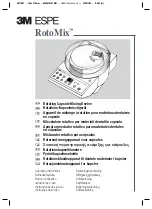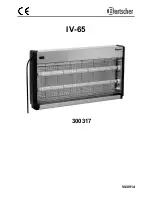
PFT G 54 E
Operating Instructions
09/2006
Knauf PFT GmbH & Co.KG
8
General instructions
1. The safety instructions and danger warnings on the machine must be observed and kept in a
readable condition.
2. All procedures for switching the machine on and off and control indicators and signal lamps
should be in compliance with the operating instructions.
3. Install the machine on stable and even ground and secure it against accidental movements. It
may neither tilt nor roll away. The machine must be installed in such a way that it cannot be hit
by any falling objects. The controls must be freely accessible.
4. Inspect the machine for visible damage and defects at least once every shift. When doing so,
pay special attention to electrical power cables, couplings, plugs and air, water and conveying
lines. Any visible defects must be eliminated immediately.
5. Spare parts must comply with the technical requirements of the manufacturer. This is
guaranteed for all original PFT parts.
6. The machine may only be connected to a worksite switchgear assembly with an earth-leakage
circuit breaker (30 mA). If the control system of the machine has a 3-phase frequency
converter, the 30 mA earth-leakage circuit breaker of the worksite switchgear assembly must
be sensitive to all currents.
7. The machine may only be put into service by trained or instructed personnel. Clearly define the
responsibilities of the staff for operation, setup, maintenance and repairs.
8. Personnel undergoing training should only be allowed to operate the machine under the
supervision of experienced personnel.
9. Work on electrical equipment of the machine may only be carried out by qualified electricians
or by trained personnel under the supervision of a qualified electrician in accordance with
electro-technical regulations.
10. The machine must be completely switched off for maintenance and repairs and secured
against being accidentally switched back on again (lock the main switch and pull the key, for
example, or attach a warning sign to the main switch).
11. If work has to be carried out on live components, a second person should be present to
disconnect the power in the event of an emergency.
12. Depressurise all conveying systems before opening conveying lines.
13. Before cleaning the machine with a water jet, seal all openings through which water could enter
and impair the safety and functions of the machine (e.g.: electric motors and control boxes).
Remove all covers after cleaning.
14. Only use original fuses of the prescribed amperage.
15. Disconnect the machine from any external power supplies before relocating it, even it is only to
be moved a short distance. The machine should be connected properly to the mains before
being restored to service.
16. The machine may only be moved by a crane if it is firmly strapped to a Euro pallet. All
removable parts must be removed first. Make sure nobody enters the danger area of the crane.
All precautions must be taken to prevent parts from falling down.
17. Safety devices such as inclination switches, protective grilles etc. may not be manipulated. The
safety devices should be checked separately before beginning with work.
18. Longer work breaks can cause the mortar to set, resulting in malfunctions during operation.
This is why the machine (incl. spraying gun and conveying hoses) should always be emptied
and cleaned during long breaks.
19. Never put any objects in the dry mortar hopper or pump container.
20. Appropriate noise protection devices must be provided if the permanent noise level exceeds
85 dB (A).
21. The machine must be inspected by a specialist once a year. This inspection must be
documented and include a visual inspection for damage, a functional check, an inspection of
the safety devices and a high-voltage check of the control box.
22. Safety-relevant components can be damaged by frost. Drain the machine whenever there is a
danger of frost.
23. The machine’s lubrication and maintenance schedule must be complied with, since otherwise
the warranty will lose its validity.









































